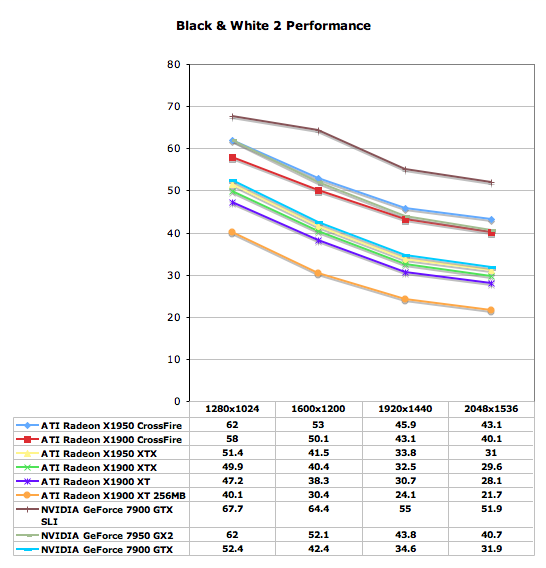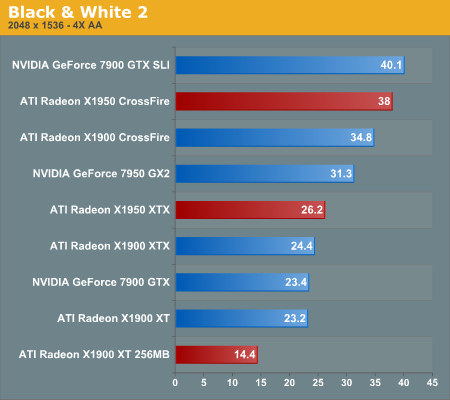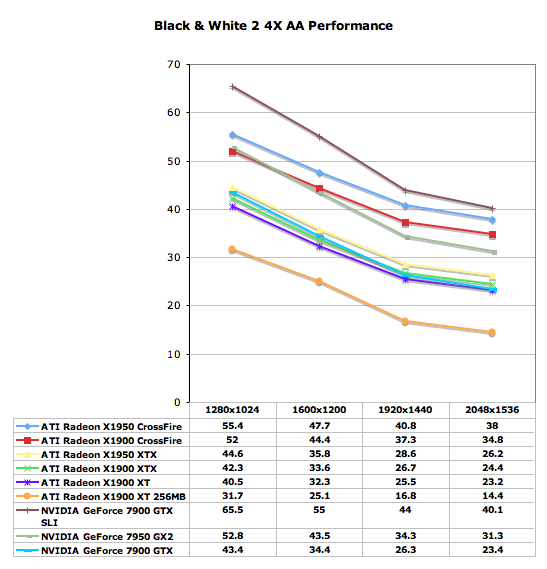ATI's New High End and Mid Range: Radeon X1950 XTX & X1900 XT 256MB
by Derek Wilson on August 23, 2006 9:52 AM EST- Posted in
- GPUs
Black & White 2 Performance
The AnandTech benchmark for Black & White 2 is a FRAPS benchmark. Between the very first tutorial land and the second land there is a pretty well rounded cut scene rendered in-game. This benchmark is indicative of real world performance in Black & White 2. We are able to see many of the commonly rendered objects in action. The most stressful part of the benchmark is a scene where hundreds of soldiers come running over a hill, which really pounds the geometry capabilities of these cards. At launch, ATI cards were severely out matched when it came to B&W2 performance because of this scene, but two patches applied to the game and quite a few Catalyst revisions later give ATI cards a much needed boost in performance over what we first saw.
A desirable average framerate for Black & White 2 is anything over 20 fps. The game does remain playable down to the 17-19 fps range, but we usually start seeing the occasional annoying hiccup during gameplay here. While this isn't always a problem as far as getting things done and playing the game, any jerkiness in frame rate degrades the overall experience.
We did test with all the options on the highest quality settings under the custom menu. Antialiasing has quite a high performance hit in this game, and is generally not worth it at high resolutions unless the game is running on a super powerhouse of a graphics card. If you're the kind of person who just must have AA enabled, you'll have to settle for a little bit lower resolution than we tend to like on reasonably priced graphics card. Black & White 2 is almost not worth playing at low resolutions without AA, depth of field, or bloom enabled. At that point, we tend to get image quality that resembles the original Black & White. While various people believe that the original was a better game, no one doubts the superiority of B&W2's amazing graphics.

So far things aren't looking good for ATI's multi-GPU solution making its way to the top of the charts, as the 7900 GTX SLI significantly outperforms the X1950 CrossFire setup. Once again, we see that the X1950 CrossFire is barely faster than a single 7950 GX2 but, to ATI's credit, Black & White 2 has never been a strength of the X1000 series.
Single card performance is a bit closer, as the 7900 GTX offers the same performance as the X1950 XTX. Although the 7950 GX2 is technically a single card, its dual GPUs let it perform like a multi-card solution, and its price shows. The 7950 GX2 offers an interesting middle ground between the price and performance of a top of the line single GPU solution like the X1950 XTX or 7900 GTX and a full blown multi-card multi-GPU setup.
Once again it's worth noting that even the $280 X1900 XT 256MB is able to average a playable frame rate at 2048 x 1536, making a case for the value to be had in a sub-$300 graphics card.


With AA enabled, the X1950 CrossFire vs. 7900 GTX SLI gap narrows considerably, and on the single card side the X1950 XTX manages to outperform the 7900 GTX. Thanks to better scaling with NVIDIA's SLI, the 7900 GTX more than makes up for the gap when you add a second card.
With 4X AA enabled, the X1900 XT 256MB can no longer hang with the big boys. However, it's worth mentioning that at higher resolutions, the visual benefit of anti-aliasing quickly diminishes. As pixel size decreases, visible aliasing becomes much less of a problem and if it's bothering you that much at 2048 x 1536 we may need to sit you down and have a talk about the old days when we didn't have anti-aliasing (and we had to benchmark in the snow).











74 Comments
View All Comments
SixtyFo - Friday, September 15, 2006 - link
So do they still use a dongle between the cards? If you had 2 xfire cards then it won't be connecting to a dvi port. Is there an adaptor? I guess what I'm asking is are you REALLY sure I can run 2 crossfire ed. x1950s together? I'm about to drop a grand on video cards so that piece of info may come in handy.unclebud - Friday, September 1, 2006 - link
"And 10Mhz beyond the X1600 XT is barely enough to warrant a different pair of letters following the model number, let alone a whole new series starting with the X1650 Pro."nvidia has been doing it for years with the 4mx/5200/6200/7300/whatever and nobody here said boo!
hm.
SonicIce - Thursday, August 24, 2006 - link
How can a whole X1900XTX system use only 267 watts? So a 300w power supply could handle the system?DerekWilson - Saturday, August 26, 2006 - link
generally you need something bigger than a 300w psu, because the main problem is current supply on both 12v rails must be fairly high.Trisped - Thursday, August 24, 2006 - link
The crossfire card is not the same as the normal one. The normal card also has the extra video out options. So there is a reason to buy the one to team up with the other, but only if you need to output to a composite, s-video, or component.JarredWalton - Thursday, August 24, 2006 - link
See discussion above under the topic "well..."bob4432 - Thursday, August 24, 2006 - link
why is the x1800xt left out of just about every comparison i have read? for the price you really can't beat it....araczynski - Thursday, August 24, 2006 - link
...I haven't read the article, but i did want to just make a comment...having just scored a brand new 7900gtx for $330 shipped, it feels good to be able to see the headlines for articles like this, ignore them, and think "...whew, i won't have to read anymore of these until the second generation of DX10's comes out..."
I'm guessing nvidia will be skipping the 8000's, and 9000's, and go straight for the 10,000's, to signal the DX10 and 'uber' (in hype) improvements.
either way, its nice to get out of the rat race for a few years.
MrJim - Thursday, August 24, 2006 - link
Why no Anisotropic filtering tests? Or am i blind?DerekWilson - Saturday, August 26, 2006 - link
yes, all tests are performed with at least 8xAF. Under games that don't allow selection of a specific degree of AF, we choose the highest quality texture filtering option (as in BF2 for instance).AF comes at fairly little cost these days, and it just doesn't make sense not to turn on at least 8x. I wouldn't personally want to go any higher without angle independant AF (like the high quality af offered on ATI x1k cards).